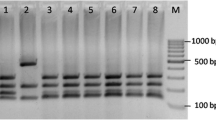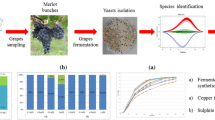Abstract
The principal agent in winemaking is the yeast Saccharomyces cerevisiae, which is characterized by a significant strain biodiversity. Here we report the characterization of 80 wild S. cerevisiae strains, isolated from grapes of different varieties in southern Italy, for genetic and technological variability. By PCR amplification with M13 primer a significant polymorphism was recorded and 12 different biotypes were identified among the strains. The specific strain-pattern could be used to follow the dynamics of different biotypes during the fermentation process. The analysis of experimental wines obtained by inoculated fermentations with the 80 strains showed significant differences among the wines. The level of each compound was a function of the strain performing the fermentative process. The main variables for the strain differentiation were the production of acetaldehyde and acetic acid, which ranged from 53 to 282 mg/l and from 0.20 to 1.88 g/l, respectively. Selected strains were tested in fermentation with two different grape musts, yielding experimental wines differing in the levels of secondary compounds and polyphenol content, in function of the interaction “grape must composition/yeast strain”. This finding has an applicative value for the potentiality of utilizing the resource of strain variability as a tool to individuate suitable starter cultures, which are able to complement and optimize grape quality.




Similar content being viewed by others
References
Antonelli A (1994) Ethanol determination by packed GLC: a quick methods with small sample amount and high sensitività. Die Wein-Wissenschaft 49(4):165–167
Brandolini V, Fiore C, Maietti A, Tedeschi P, Romano P (2007) Influence of Saccharomyces cerevisiae strains on wine total antioxidant capacity evaluated by photochemiluminescence. World J Microbiol Biotechnol 23:581–586
Capece A, Salzano G, Romano P (2003) Molecular typing techniques as a tool to differentiate non-Saccharomyces wine species. Int J Food Microbiol 84:33–39
Di Stefano R, Cravero MC, Gentilizi N (1989) Metodi per lo studio dei polifenoli dei vini. L’Enotecnico 5:83–89
Esteve-Zarzoso B, Belloch C, Uruburu F, Querol A (1999) Identification of yeasts by RFLP analysis of the 5.8S rRNA gene and the two ribosomal internal transcribed spacers. Int J Syst Bacteriol 49:329–337
Fleet GH (2003) Yeast interactions and wine flavour. Int J Food Microbiol 86:11–22
Frezier V, Dubourdieu D (1992) Ecology of yeast strain Saccharomyces cerevisiae during spontaneous fermentation in a Bordeaux winery. Am J Enol Vitic 43:375–380
Henschke PA (1997) Wine yeast. In: Zimmermann FK, Entian KD (eds) Yeast sugar metabolism: biochemistry, genetics, biotechnology and applications. Technomic Publishing, New York, pp 527–560
Lambrechts MG, Pretorius IS (2000) Yeast and its importance to wine aroma-A review. SA J Enol Vitic 21:97–128
Lema C, Garcia-Jares C, Orriols I, Angulo L (1996) Contribution of Saccharomyces and non-Saccharomyces populations to the production of some components of Albariño wine aroma. Am J Enol Vitic 47:206–216
Lurton I, Snakkers G, Roulland C, Galy B, Versavaud A (1995) Influence of the fermentation yeast strain on the composition of wine spirits. J Sci Food Agric 67:485–491
Polsinelli M, Romano P, Suzzi G, Mortimer M (1996) Multiple strains of Saccharomyces cerevisiae on a single grape wine. Lett Appl Microbiol 22:110–114
Pretorius IS (2000) Tailoring wine yeast for the new millennium: novel approaches to the ancient art of winemaking. Yeast 16:675–729
Querol A, Barrio E, Ramon D (1992) A comparative study of different methods of yeast strain characterisation. Syst Appl Microbiol 15:439–446
Romano P (1997) Metabolic characteristics of wine strains during spontaneous and inoculated fermentation. Food Technol Biotechnol 35(4):255–260
Romano P, Suzzi G, Turbanti L, Polsinelli M (1994) Acetaldehyde production in Saccharomyces cerevisiae wine yeasts. FEMS Microbiol Lett 118:213–218
Romano P, Caruso M, Capece A, Lipani G, Paraggio M, Fiore C (2003a) Metabolic diversity of Saccharomyces cerevisiae strains from spontaneously fermented grape must. World J Microbiol Biotechnol 19:311–315
Romano P, Fiore C, Paraggio M, Caruso M, Capece A (2003b) Function of yeast species and strains in wine flavour. Int J Food Microbiol 86:169–180
Schütz M, Gafner JD (1993) Analysis of yeast diversity during spontaneous and induced alcoholic fermentations. J Appl Bacteriol 75:551–558
Acknowledgements
This research was partially supported by the POR Basilicata Region (2000–2006). The authors wish to thank the winemakers for supplying grape musts for performing laboratory fermentation tests.
Author information
Authors and Affiliations
Corresponding author
Rights and permissions
About this article
Cite this article
Romano, P., Capece, A., Serafino, V. et al. Biodiversity of wild strains of Saccharomyces cerevisiae as tool to complement and optimize wine quality. World J Microbiol Biotechnol 24, 1797–1802 (2008). https://doi.org/10.1007/s11274-008-9672-z
Received:
Accepted:
Published:
Issue Date:
DOI: https://doi.org/10.1007/s11274-008-9672-z




